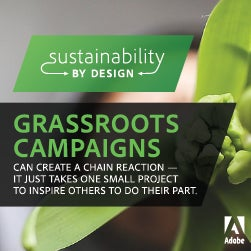Grassroots Sustainability: You Can Be the Difference

Sustainability by Design is a series of articles that looks at ideas for building a culture of sustainability — from employee leadership to product design and corporate reporting.
In 2009, a group of our employees in San Jose, Calif., wanted to encourage their co-workers to live more sustainably, so they planted a rooftop garden and launched a brown-bag lunch series featuring guest speakers who were experts on environmental topics. This first employee-led sustainability group empowered us all to participate in sustainability solutions at work and at home. Our employees have been a driving force for our own sustainability program from the beginning and we’ve harnessed that energy as it has grown over the years.
Grassroots campaigns can create a chain reaction — it just takes one small project to inspire others to do their part. Today we have 22 employee-led teams around the world that focus on programs to offer quick, easy ways to engage on key environmental issues. At a recent gathering, more than 200 employees lined up during lunch to purchase discounted energy and water conservation kits. Many people participated because it was a low-effort habit change that would also save them money.
The rooftop garden started at our San Jose office is still providing vegetables, and it inspired the San Francisco office to start their own office garden. More than 35 employees tend the garden and grow vegetables for a non-profit that provides free produce to people in San Francisco’s Tenderloin district. That’s the kind of tangible result employees can achieve as they continue to attract and keep others committed and engaged in a sustainability program. It has a tremendous impact on communities as well as the environment.
Launch Your Own Program in Five Steps
Are you interested in encouraging sustainability at your workplace? It doesn’t matter what group you are in — finance, engineering, marketing or HR — it only takes one committed employee to make a difference. Here are five steps to help you get started:
1. Understand Your Company’s Sustainability Strategy. Take the time to understand your company’s vision for sustainability — or, if it doesn’t have one think about how your company’s mission, products, and work processes affect the environment. The point here is that connecting your efforts to what your company does helps your colleagues feel engaged both personally and with the company
2. Select Champions. Finding like-minded coworkers may be a challenge when working from the bottom up. Take notice of others who already practice green habits as simple as recycling waste. Remember that recruiting the right people is essential for setting the tone of the program and that these people will be your leaders — they will be the ones on the ground at each location to run local events.
For example, at our San Jose headquarters, sustainability champions have organized the Guadalupe river cleanup by our buildings every year for the past eight years. In our Sydney office, sustainability champions organize a yearly beach cleanup.
3. Determine a Theme. It’s important to have structure to maintain program momentum throughout the year — not just around Earth Day, although that can be a great starting point. Consider themes based on your company’s corporate responsibility strategy, and then repeat the themes at certain intervals each year. Some ideas include renewable energy, sustainability at home, water conservation, and waste reduction.
Develop specific activities for each theme. During a waste reduction theme, for example, hold a Freecycle event. Employees can bring in items they don’t use, including electronics and household items, and other team members can take what they want. At the end of the event, donate any leftover items to a thrift store. Without this event, many of the items might have ended up in a landfill. Choosing themed activities that appeal to a wide range of employees can have a bigger impact.
4. Make Sustainability Pay Off. Once your colleagues are aware and educated about sustainability strategies at work, many of them want to do more at home. By creating a variety of theme-based activities you can support sustainability at work and in the community. For example, we negotiate 10-15 percent discounts on items (both locally and globally) sustainability champions identify to support employees in adapting sustainable practices at home.
When our sustainability theme focused on renewable energy, Adobe offered discounts on at-home solar panels. Electric vehicle and charger discounts, as well as electric vehicle test drive events, were also very popular with employees. Because we have set a goal of powering our operations and the digital delivery of products with 100 percent renewable energy sources, these activities help employees connect with that goal on a personal level.
5. Get Support. This doesn’t need to be your last step, but the more engaged employees are with sustainability activities, the more likely you will be to receive support from your company’s management. In addition, aligning your ideas with your company’s sustainability goals should make getting support an easy sell. And support can come in a variety of ways — from space to meet to help with communication and budget for supplies to negotiating discounts. The more involved your company becomes, the more impact your efforts can have.
Our corporate responsibility team supports employee efforts with a kickoff meeting each quarter. They provide a guide with a theme and project ideas that can be implemented by sustainability champions at local sites. Since each location is unique, this allows employees the flexibility to organize projects that will resonate with their own co-workers, while still having the support of a larger team.
How do you grow employee sustainability efforts at your company? Continually attract and engage with more employees. Offer a wide range of meaningful projects and opportunities — from discounted conservation kits to gardening on the roof. Make it easy for everyone to be an environmental advocate at work and at home.